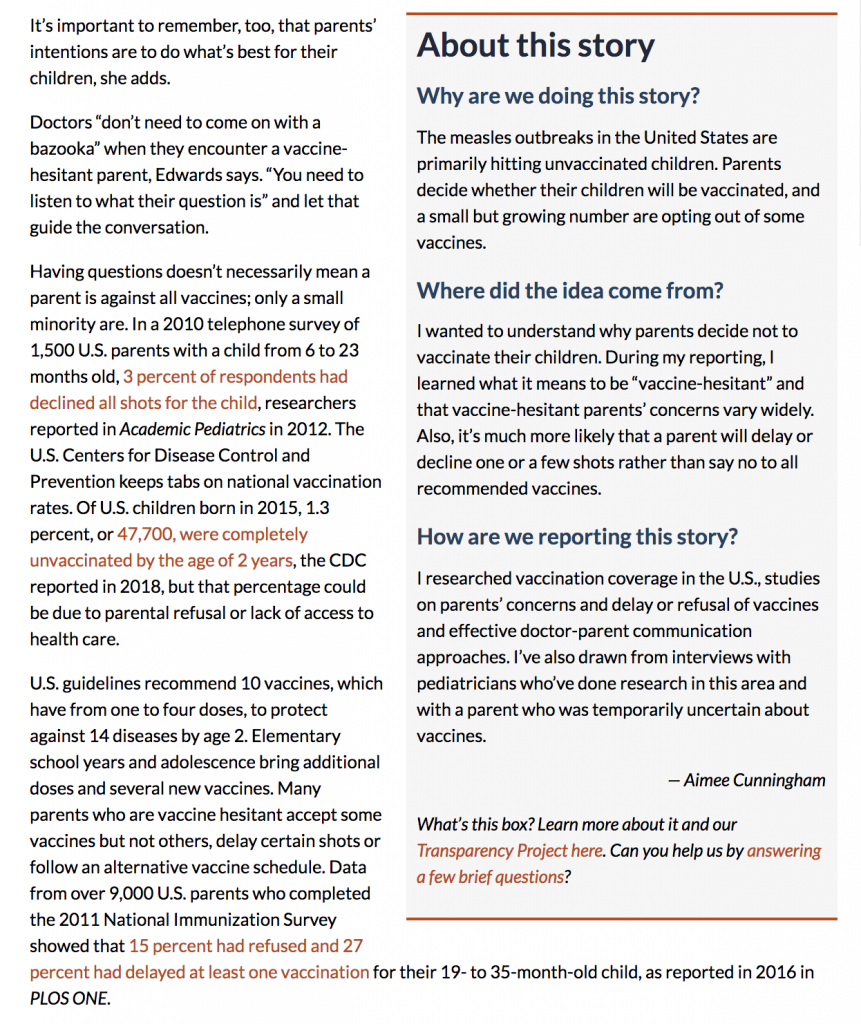Science News launches Transparency Project

In this new initiative, science journalists explain how and why stories are reported.
Much has been written about the trust problem we’re facing in the U.S. — really, worldwide. Edelman’s annual Trust Barometer reports there is a growing gap in trust between a more trusting informed public and a skeptical general population.
Part of the collateral damage of declining trust is a growing science denial that has impacted scientific research and even science journalism.
Though Science News, the venerable news organization of the Society for Science and the Public, has an audience of science enthusiasts, it has not entirely been shielded from the growing distrust and politicization of science and science journalism. Editor in Chief Nancy Shute and her team knew they could do more to explain their process, and recognized the importance of doing so in today’s news environment.
Nancy was intrigued by work the News Co/Lab was doing with newsrooms in several McClatchy communities to help readers better understand the reporting process and how and why certain editorial decisions were made. The News Co/Lab hypothesized that similar transparency efforts would especially benefit science news outlets for a couple reasons — the subject matter is often difficult to understand and potentially controversial, and the pervasiveness of junk science news makes it difficult to set apart quality journalism.
Thus, the Transparency Project was born. Components of the project include extended “shirttail” bios at the end of stories that share the reporter’s experience and science bonafides (which are typically quite impressive) and an “About the Story” sidebar on its website. The sidebar provides additional context for a complex or controversial story, including the story idea’s origin, how sources were chosen and how the story was reported. In some cases, a separate article is devoted to the making of the story.
Science News already included citations and recommendations for further reading on its stories, but the “About the Story” descriptions offer an inside look into the reporting process, written in a conversational voice. Stories address different questions based on their content and, importantly, include a feedback form to assess how the information improves perceptions of trust and credibility. At the time of this writing, 45 people had filled out the form across nine different stories. None of the respondents rated Science News below a 4 on a 5-point scale for trustworthiness and credibility.
Readers’ positive comments on the feedback form offer insight into how transparency initiatives can help meet readers’ needs. For instance, several comments came from educators who said the transparency box will make it easier to teach the subject of the article in their classrooms. Others said it was an important contribution to Science News coverage in an age of misinformation. And some acknowledged it was helpful to understand why certain information and sources were chosen in favor of others — even if the reader didn’t agree with the choices.
Here’s just one example of reader feedback:
“I do a lot of literature research myself and make connections between resources that help explain the potentially unexplainable. I like knowing that more professional writers do the same, and are willing to admit how they reached their conclusions, particularly if their conclusions may conflict with others.”
Next steps for the Transparency Project include adding “About the Story” boxes to selected print stories and exploring other transparency formats for the web and social media. The News Co/Lab believes these early positive results help make the case for journalistic transparency as a media literacy practice, one that can be especially beneficial in specific subject areas. The scientific method and journalistic reporting process may be generally understood, but there can be confusion, especially when journalists write about science. Opening up about the process can not only engender trust, but it can also help readers develop skills to better identify credible journalism.

Kristy Roschke, managing director of the ASU News Co/Lab, is a media scholar and educator. Her research interests include misinformation, media literacy education and media trust. Roschke has developed curriculum and taught journalism and media literacy courses at the high school and university level for nearly 20 years.

